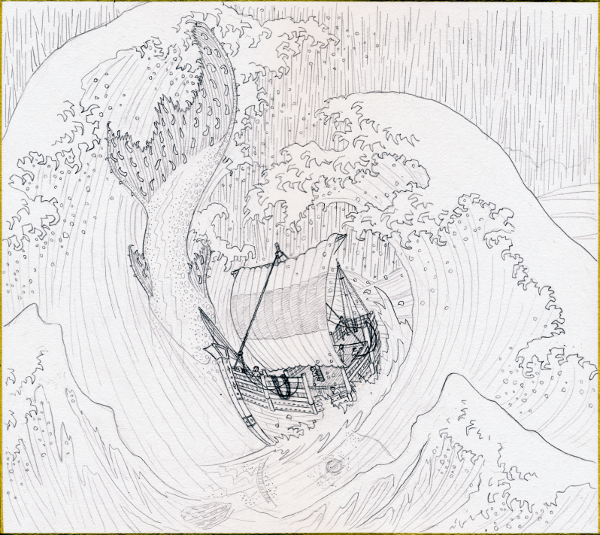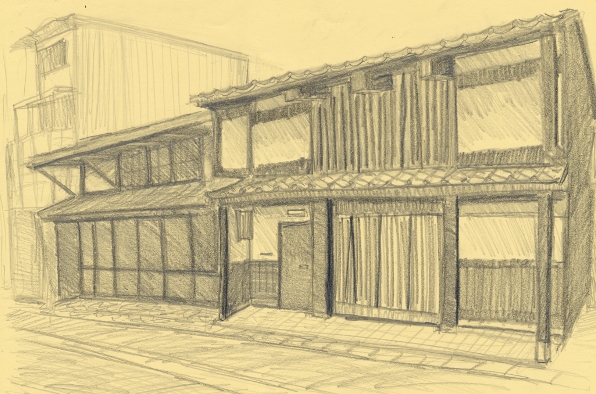Fall here in Hokuriku is as beautiful as anywhere on Earth, but there is one thing that, at least for me, makes it especially special. There is some kind of fragrance — whether it’s a flower or a tree, or a special kind of incense coming from the many temples here in Takefu, I have no idea — a sweet and fresh smell that lingers all over in the air. It only lasts for a few weeks from the end of September throughout some of October. When I was riding my bike through town to get to aikido earlier, the smell was so enthralling and entrancing that I could have ridden down that rode forever — or at least until it went deep into the mountains. It’s a good thing I didn’t, though, for I might have run into today’s yokai:
Mujina
There are a number of yokai based on real animals. You may remember the tanuki and the kitsune from last year’s A-Yokai-A-Day. Today’s yokai is another. Mujina is a Japanese name for the badger; although today badgers are usually called anaguma. In Japanese folklore, the badger is a magical animal with shapeshifting abilities and a penchant for playing tricks on humans. They’re not malevolent, but neither are they benevolent. Sometimes they do good, and sometimes they do very bad things, but most of the time they just like the screw with us pathetic humans.
At least in English, the mujina is often associated with the noppera-bo, which you may also remember from last year. This is because of a famous folktale transcribed by the famous Lafcadio Hearn, a folklorist from a century ago who collected and translated many of Japan’s folklore and customs, and is one of the most famous foreigners-turned-Japanese. Hearn told the tale of the noppera-bo, but in his story he refers to the monster as a mujina. It’s possible that when he was told the story, the noppera-bo was actually a shapeshifted mujina, or perhaps it was a human transformed by a mujina’s magic. (I’ve read in other places that mujina are fond of taking the form of faceless people, and are known for turning people into noppera-bos when it suits them, but those may also just be the result of Hearn’s mistranslation.) In any case, I don’t think I would want to get on the bad side of a badger — magical or not.

Mujina (with a Noppera-bo)
Matted prints will be available on my Etsy store pretty soon, so please check back again later this week. If you’re interested in buying the original, please send me an email via my contact form.
Mujina, by Lafcadio Hearn
from Kwaidan (1904)
On the Akasaka Road, in Tôkyô, there is a slope called Kii-no-kuni-zaka, — which means the Slope of the Province of Kii. I do not know why it is called the Slope of the province of Kii. On one side of this slope you see an ancient moat, deep and very wide, with high green banks rising up to some place of gardens; — and on the other side of the road extend the long and lofty walls of an imperial palace. Before the era of street-lamps and jinrikishas, this neighborhood was very lonesome after dark; and belated pedestrians would go miles out of their way rather than mount the Kii-no-kuni-zaka, alone, after sunset.
All because of a Mujina that used to walk there.
The last man who saw the Mujina was an old merchant of the Kyôbashi quarter, who died about thirty years ago. This is the story, as he told it :—
One night, at a late hour, he was hurrying up the Kii-no-kuni-zaka, when he perceived a woman crouching by the moat, all alone, and weeping bitterly. Fearing that she intended to drown herself, he stopped to offer her any assistance or consolation in his power. She appeared to be a slight and graceful person, handsomely dressed; and her hair was arranged like that of a young girl of good family. “O-jochû,” he exclaimed, approaching her,— “O-jochû, do not cry like that!… Tell me what the trouble is; and if there be any way to help you, I shall be glad to help you.” (He really meant what he said; for he was a very kind man.) But she continued to weep,— hiding her face from him with one of her long sleeves. “O-jochû,” he said again, as gently as he could,— “please, please listen to me! … This is no place for a young lady at night! Do not cry, I implore you!— only tell me how I may be of some help to you!” Slowly she rose up, but turned her back to him, and continued to moan and sob behind her sleeve. He laid his hand lightly upon her shoulder, and pleaded:— “O-jochû!— O-jochû!— O-jochû!… Listen to me, just for one little moment!… O-jochû!— O-jochû!”… Then that O-jochû turned round, and dropped her sleeve, and stroked her face with her hand;— and the man saw that she had no eyes or nose or mouth,— and he screamed and ran away.
Up Kii-no-kuni-zaka he ran and ran; and all was black and empty before him. On and on he ran, never daring to look back; and at last he saw a lantern, so far away that it looked like the gleam of a firefly; and he made for it. It proved to be only the lantern of an itinerant soba-seller, who had set down his stand by the road-side; but any light and any human companionship was good after that experience; and he flung himself down at the feet of the old soba-seller, crying out, “Aa!— aa!!— aa!!!“…
“Kore! Kore!” roughly exclaimed the soba-man. “Here! what is the matter with you? Anybody hurt you?”
“No— nobody hurt me,” panted the other,— “only… Aa!— aa!“…
“— Only scared you?” queried the peddler, unsympathetically. “Robbers?”
“Not robbers,— not robbers,” gasped the terrified man… “I saw… I saw a woman— by the moat;— and she showed me… Aa! I cannot tell you what she showed me!”…
“He! Was it anything like THIS that she showed you?” cried the soba-man, stroking his own face— which therewith became like unto an Egg… And, simultaneously, the light went out. | 「今日の妖怪シリーズ」、今日は「むじな」です。
昨年の「今日の妖怪シリーズ」で狸や狐を描きましたが、今回も動物がベースになっている妖怪です。
「むじな」とは、現在はアナグマと呼ばれている動物です。人間をだまし、化けることもできますが、大変ひどい妖怪ではありません(やさしくもありませんが)。時々いいこともしますが、弱い人間にいじわるをするなど悪いこともよくします。
英語では、「むじな」はラフカディオ・ハーンさんの翻訳によって、「のっぺらぼう」と関連して知られています。「のっぺらぼう」も昨年の「今日の妖怪シリーズ」で描きましたので、ギャラリーの中から探してみてくださいね。ハーンさんによると、ムジナはのっぺらぼうに化けることができ、また人間をのっぺらぼうに変えてしまうこともできるそうです。怖いですね。

ムジナ
「むじな」の絵は私のEtsyストアでもうすぐ購入が可能になります。オリジナルの「むじな」の購入がご希望でしたら、こちらのお問い合わせフォームからご依頼をおねがいします。世界に1枚のオリジナルですので、売れてしまう場合もございますのでご了承をお願いいたします。
Mujina, by Lafcadio Hearn
from Kwaidan (1904)
On the Akasaka Road, in Tôkyô, there is a slope called Kii-no-kuni-zaka, — which means the Slope of the Province of Kii. I do not know why it is called the Slope of the province of Kii. On one side of this slope you see an ancient moat, deep and very wide, with high green banks rising up to some place of gardens; — and on the other side of the road extend the long and lofty walls of an imperial palace. Before the era of street-lamps and jinrikishas, this neighborhood was very lonesome after dark; and belated pedestrians would go miles out of their way rather than mount the Kii-no-kuni-zaka, alone, after sunset.
All because of a Mujina that used to walk there.
The last man who saw the Mujina was an old merchant of the Kyôbashi quarter, who died about thirty years ago. This is the story, as he told it :—
One night, at a late hour, he was hurrying up the Kii-no-kuni-zaka, when he perceived a woman crouching by the moat, all alone, and weeping bitterly. Fearing that she intended to drown herself, he stopped to offer her any assistance or consolation in his power. She appeared to be a slight and graceful person, handsomely dressed; and her hair was arranged like that of a young girl of good family. “O-jochû,” he exclaimed, approaching her,— “O-jochû, do not cry like that!… Tell me what the trouble is; and if there be any way to help you, I shall be glad to help you.” (He really meant what he said; for he was a very kind man.) But she continued to weep,— hiding her face from him with one of her long sleeves. “O-jochû,” he said again, as gently as he could,— “please, please listen to me! … This is no place for a young lady at night! Do not cry, I implore you!— only tell me how I may be of some help to you!” Slowly she rose up, but turned her back to him, and continued to moan and sob behind her sleeve. He laid his hand lightly upon her shoulder, and pleaded:— “O-jochû!— O-jochû!— O-jochû!… Listen to me, just for one little moment!… O-jochû!— O-jochû!”… Then that O-jochû turned round, and dropped her sleeve, and stroked her face with her hand;— and the man saw that she had no eyes or nose or mouth,— and he screamed and ran away.
Up Kii-no-kuni-zaka he ran and ran; and all was black and empty before him. On and on he ran, never daring to look back; and at last he saw a lantern, so far away that it looked like the gleam of a firefly; and he made for it. It proved to be only the lantern of an itinerant soba-seller, who had set down his stand by the road-side; but any light and any human companionship was good after that experience; and he flung himself down at the feet of the old soba-seller, crying out, “Aa!— aa!!— aa!!!“…
“Kore! Kore!” roughly exclaimed the soba-man. “Here! what is the matter with you? Anybody hurt you?”
“No— nobody hurt me,” panted the other,— “only… Aa!— aa!“…
“— Only scared you?” queried the peddler, unsympathetically. “Robbers?”
“Not robbers,— not robbers,” gasped the terrified man… “I saw… I saw a woman— by the moat;— and she showed me… Aa! I cannot tell you what she showed me!”…
“He! Was it anything like THIS that she showed you?” cried the soba-man, stroking his own face— which therewith became like unto an Egg… And, simultaneously, the light went out.







